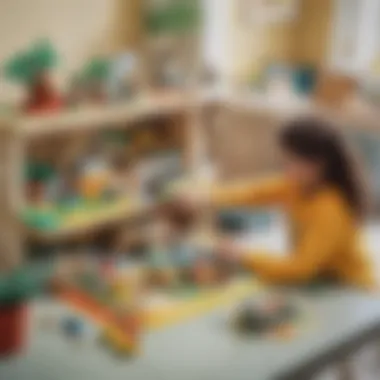The LEGO Egg Hunt: Merging Fun with Learning for Kids


Intro
In an ever-evolving educational landscape, engaging children in learning is vital. A LEGO Egg Hunt presents a novel approach to combine fun and educational experiences for kids aged 6-12. This unique concept leverages LEGO blocks and the excitement of a holiday egg hunt to facilitate playful learning. Kids naturally gravitate towards hands-on activities where they can explore, create, and think critically. Such experiences foster skills essential for their future.
The relationship between play and educational growth is continuously studied. Interactive learning encourages children to explore scientific ideas without the fear of failure. Implementing activities like a LEGO Egg Hunt caters to their imaginative nature while engaging fundamental concepts in Science, Technology, Engineering, and Mathematics (STEM). Quite simply, it’s a medium that places learning within a fun framework.
Let’s explore how incorporating a LEGO-focused egg hunt can instill both creativity, collaboration, and knowledge in young minds. Through various methods of organization and participation, children can learn in an enjoyable context while developing critical thinking skills.
Science Fun Facts
Interactive play is enriched by fun facts that can intrigue and spark curiosity among participants. Here are some engaging pieces of information about science woven around the concept of an egg hunt and LEGO blocks:
- Creativity and Structural Design: Did you know that exercising creativity while engaging in structural design can help enhance cognitive dexterity in children? Children exploring architecture using LEGO blocks think spatially and develop problem-solving abilities.
- Mathematical Foundations: Counting and organizing LEGO eggs introduces basic math concepts. Engaging in playful math tasks hones their skills as they become familiar with numbers while enjoying the egg hunt.
- Materials and Science: The material selected for eggs can provide insight into varied science topics, like buoyancy or mixing colors. For example, plastic eggs can help discuss issues related to buoyancy, whereas classic colored eggs are perfect for an art session.
“Play is the highest form of research.” – Albert Einstein
Discover the Wonders of Science
Engaging children in discovering science conceptually can set the groundwork for interest lasting many years. Here are ways to introduce scientific exploration during your LEGO Egg Hunt:
- Exploring Various Scientific Concepts: As children hunt or construct, utilize scientific principles. Whether it’s a concept like gravity while stacking eggs or discussing options during a hunt, the lean into education can be light but significant.
- Real-Life Applications of Science: Knowledge of scientific thinking applied to ordinary tasks, like building pathways for eggs or understanding the physics behind balancing objects, helps dispel the notion that science is separate from fun.
Science Quiz Time
Testing knowledge can shift into placement fun. Include innovative quizzes during the hunt. Kids may encounter challenging questions hidden within eggs that reinforce learned principles:
- Multiple Choice Questions: Place questions inside eggs related to the STEM subjects they explore with their arrays of LEGO.
- Brain Teasers and Puzzles: Designing Puzzles over and inside clues connected to LEGO creation emphasizes critical thinking and collaborative interactions as children work together.
Science Experiment Showcase
Another engaging avenue during a LEGO Egg Hunt could come from interactive experiments:
- Set up mini-experiments or just plain fun activities at different points in the egg hunt.
- For example, children can mix vinegar and baking soda in egg prototypes to demonstrate reactions. Providing a straightforward materials list will ensure preparation.
- Safety tips should not be overlooked, such as ensuring children understand the safe handling of tools or chemicals used in experimentation.
This article highlighted several ways to organize a LEGO Egg Hunt. Children can unleash their creativity while available engaging deeply in STEM learning and employing teamwork. With overseen guidance from parents, it’s an opportunity that could encourage young Science Buddies towards a brighter educational future.
Preface to LEGO and Learning
Understanding the connection between LEGO and learning is crucial for recognizing its impact on children. LEGO as a tool often extends beyond mere play to become an avenue for valuable educational experiences. This section will outline the origins of LEGO and explore how its design promotes creative thinking. By emphasizing both the historical framework and inventive facets, we can see how engaging in LEGO-based activities enables children to develop critical skills in a playful context.
The Origins of LEGO
LEGO was founded in Denmark in 1932. It began as a small company producing wooden toys. However, the company made a significant pivot in 1949, when it introduced plastic interlocking bricks. This innovation transformed the landscape of children's play. The versatility of these bricks allowed for immense creativity, making them timeless.
Over the decades, LEGO has incorporated themes that resonate with children's interests and imagination. Sets have diversified to include essential themes, such as architecture, space exploration, and even movie franchises. This range enables children to build, create, and immerse themselves in various worlds, which adds a layer of playfulness to learning.
The Role of Play in Learning
Play serves as a significant pillar in a child's development. Engaging in creative activities, such as building with LEGO, fosters imagination, improves fine motor skills, and augments problem-solving abilities. Research has demonstrated the effectiveness of play in enhancing retention of knowledge.
Through freeform play with LEGO bricks, children experience hands-on learning. This exploration allows for trial and error, which leads to a deeper understanding of concepts. For instance, while building a bridge, the child will discover why certain designs are sturdier than others, teaching them principles of engineering.


In summary, LEGO's origins reflect a long-standing commitment to creativity and innovation. When play integrates with learning, it forms a powerful toolkit for developing essential life skills. As children participate in LEGO activities, especially something like a LEGO Egg Hunt, they cultivate innovative thinking and critical reasoning in enjoyable ways.
Concept of the LEGO Egg Hunt
The concept behind the LEGO Egg Hunt represents a rich blend of play, creativity, and education. By engaging children in activities that utilize LEGO bricks in combination with traditional egg hunt elements, it fosters an environment that emphasizes learning through play. This section investigates the foundational ideas that construct the LEGO Egg Hunt and underscores how integrating enriching educational aspects can enhance both entertainment and intellectual outcomes.
Basic Idea and Structure
The LEGO Egg Hunt revolves primarily around the principles of discovery and creativity. In this format, children explore their surroundings to find hidden packets of LEGO pieces placed inside colorful eggs. Once discovered, these pieces can be instantly transformed into various builds, unleashing their imagination.
To organize an effective LEGO Egg Hunt, consider these main points:
- Set clear objectives: For example, inspire exploration, promote teamwork, or encourage constructive creativity.
- Preparation of eggs: In addition to holding LEGO pieces, eggs can also contain challenge cards which present tasks or questions to guide building activities or group interactions.
- Layout design: Creating distinct zones within the hunting area is important. Each zone can have variations in difficulty level or specific themes, adding more excitement.
Ensuring that new inventions, rather than old views of play, take focus, strucuture becomes vital. Evaluating how teams manage to work together as they build fosters an inclusive atmosphere for participants.
Incorporating STEM Elements
One of the most significant advantages of a LEGO Egg Hunt is its ability to serve as a subtle introduction to STEM concepts. Incorporating elements of science, technology, engineering, and math into the play framework promotes cognitive growth while they participate in a fun, engaging environment.
Some specific ways to integrate STEM:
- Building Challenges: Utilize eggs with varying themes. For instance, some eggs might contain specific instructions to build a bridge or vehicle. This encourages engineering skills as children must solve design problems.
- Scientific Observations: As builds take shape, encourage kids to think about the materials’ interactions. Questions might arise about stability, gravity, or movement, pushing them to connect theory and practice.
- Mathematical Principles: When constructing with LEGO, various computations become necessary, whether measuring distances or counting pieces. Children involuntarily use basic math skills during their play.
Overall, the integration of STEM into the LEGO Egg Hunt generates a myraid of learning opportunities as they engage deeply with their surroundings and REFLECT actively on their creation journey.
Through well-thought-out structure and an embedded STEM approach, the LEGO Egg Hunt serves not just as a playful event but also as a holistic learning experience for children.
Planning a LEGO Egg Hunt
Planning a LEGO Egg Hunt is an essential component for maximizing the event's potential as both a fun and educational experience. Careful consideration of different elements is crucial for fostering engagement and creating a memorable adventure for children aged 6-12. Here, we will explore necessary factors like the venue, appropriate LEGO sets, and effective clues, ensuring everything works harmoniously to benefit the participants.
Setting Up the Venue
An appropriate venue can greatly influence the overall atmosphere and flow of the LEGO Egg Hunt. When setting up, you should consider factors such as safety, space, and accessibility. Outdoor spaces like parks or large backyards offer ample room for running and searching while providing a rich backdrop of nature. If using an indoor area, ensure there is enough space for groups to move around without clustering.
Here are some elements to think about when setting up the venue:
- Safety First: Inspect the area beforehand for any hazards—playground equipment and water features, in particular, should be monitored.
- Signs and Markings: Clearly mark boundaries to help participants understand where the egg hunt will take place.
- Stations for Action: Create stations that focus on specific activities related to LEGO building or challenges. Children can work on their group teamwork skills while waiting for their turn.
- Inclusive Zones: Design spaces for kids of all abilities, allowing everyone to actively engage without barriers.
Choosing the Right LEGO Sets
Selecting appropriate LEGO sets is critical in planning a successful hunt. The chosen sets should cater to various skills and interests, ensuring that all participants find joy in the building experience. Consider these factors when selecting sets:
- Age Appropriateness: Ensure that all selected sets are safe and suitable for the target age group. Look for sets that promote open-ended creativity, like LEGO Classic or LEGO Creator.
- Thematic Relevance: Choose sets that align with any specific themes you might incorporate—seasonal motifs or adventure themes can enhance engagement and excitement among participants.
- Quantity and Diversity: Have an ample variety of sets to accommodate different preferences and teamwork dynamics. Consider combining brick-filled bags with themed kits.
By providing diverse options, you allow participants to mix and match creation during the hunt, promoting curiosity and continual learning.
Designing the Egg Hunt Clues
The clues for the LEGO Egg Hunt play a significant role in intertwining educational elements with play. Well-designed clues can encourage problem solving, critical thinking, and creative approach toward the task at hand. Here are strategies to design clues effectively:


- Interactive Clues: Design clues that require children to create or build something at each station before proceeding to the next, integrating fun and challenges.
- Variety in Difficulty: Offer different levels of clue complexity to accommodate various skill levels. This way, all participants engage—whether they grasp immediate hints or take their time to figure them out.
- Rewarding Experiences: Frame clues in such a way that they lead children to small prizes or snacks at each stop, providing immediate rewards that continue to build excitement.
- Utilizing Themes: Enhance each clue by relating it to STEM fields. For example, a clue with a science theme could initiate discussions on gravity or engineering principles while they are discovering where to search next.
The design of the clues can amplify learning experiences, turning the simple act of hunting for eggs into a thoughtful exploration of concepts.
In the end, a well-planned LEGO Egg Hunt can show how creativity, teamwork, and learning can happen at the same time.
Participating in the LEGO Egg Hunt
Participating in the LEGO Egg Hunt presents a dynamic fushion of fun and learning for children. Through interactive activities, they engage in develop important skills such as critical thinking, creative expression, and collaboration. This process does not only enhance their understanding of concepts, but also promotes life-long skills through enjioyable experience.
Team Dynamics and Collaboration
Engagement in a team enhances the overall experience of the LEGO Egg Hunt. Children have the opportunity to learn from one another and share ideas. Working together allows them to build a sense of community. When participants collaborate on challenges posed during the hunt, it naturally encourages them to communicate. Children can discuss strategies and share insights, thus enriching their learning encounters.
Throughout this process, they develop an understanding of their own roles and how they can contribute to the completion of objectives.
Consequently, teamwork becomes paramount. They become accustomed to aligning their motions with others, effectively constructing a plan for finding eggs or solving problems. This not only fabricates a stronger relationship among peers but also improves their delivery of respect, patience, and empathy. It becomes an educational incubator.
"Together you are stronger."
Problem Solving and Critical Thinking
The hunt inherently requires kids to engage their analytical abilities. Problem solving and critical thinking emerge when they approach puzzles or decipher clues. Each egg may encompass a task or riddle, designed to stretch their cognitive capabilities.
For instance, if a clue refers to a specific LEGO set or employs mathematical hints, it prompts them to think sharply and draws them into complex reasoning.
Children c an also explore various strategies for tackling problems instance through trial and error, adapting their approach as they uncover new information. This cycle fosters a mindset adjustable for future tasks.
In summary, participating in the LEGO Egg Hunt not only catalyzes dynamic teamwork but also instills significant skills in problem solving and critical thought. Young ones develop a robust foundation for lifelong learning.
Benefits of the LEGO Egg Hunt
The benefits of the LEGO Egg Hunt extend far beyond sheer entertainment. This unique blend of creativity and learning can play an integral role in developing various essential skills among children. Each stage of the hunt can facilitate a broad range of learning goals, offering abundant opportunities for personal growth, cognitive development, and social interaction. With a structured approach to the event, the advantages become even more pronounced, equipping young participants with tools that stretch well into their future.
Enhancing Creativity
A primary benefit of the LEGO Egg Hunt is its capacity to enhance creativity in children. LEGO has long been viewed as a catalyst for imaginative expression. In a hunt scenario, children use their construction skills to create innovative hiding spots or builds that reflect their unique perspectives. Furthermore, different egg designs can nurture kids' visual creativity by encouraging them to think about themes and aesthetics.
This event promotes open-ended play, which allows kids to experiment with new designs or configurations. Uncovering eggs enhances their excitement, making their brain actively free to explore multiple possibilities. By choosing which parts to combine, they make individual choices that contribute to fulfilling their own imaginative processes.
“Creativity is intelligence having fun.” — Albert Einstein
Encouraging Active Learning
Active learning is vital for thorough understanding and retention of information. The LEGO Egg Hunt inherently incorporates this concept, as it requires children to engage physically and mentally. They search for eggs, solve clues, and make sense of their surroundings whilst interacting with both the environment and other participants.
In accomplishing tasks, they develop spatial skills, logical reasoning, and, importantly, self-directed learning. The inclusion of STEM elements encourages children to utilize their inquiry skills. They become involved in problem-solving in real-time,choosing the best approach that yields effective results. Active learning not only reinforces basic knowledge but helps in internalizing complex ideas effortlessly.
Building Social Skills
Another significant aspect of the LEGO Egg Hunt is its role in fostering social skills among participants. As children work together in teams to embark on the search, collaboration becomes crucial. They learn how to communicate effectively with peers, decide on strategies, divide tasks, and encourage each other.


This cooperative environment promotes empathy and cultural understanding as they navigate obstacles together. Additionally, it builds resilience, teaching children to handle challenges without letting frustration derail their enthusiasm. Increased social interaction often leads to better emotional intelligence, which plays a pivotal part in interpersonal relationships later in life.
The LEGO Egg Hunt therefore becomes a platform for richer experiences that empowered children not only as individuals but also as participatory members of that collective adventure.
Parental Guidance and Support
In orchestrating a LEGO Egg Hunt, the involvement of parents and caregiver personas is quite crucial. This contribution ensures not only the safety and engagement of children but also the overall success of the event. The impact of parental guidance can significantly enrich a child's learning experience, fostering a productive and enjoyable atmosphere.
Creating a Safe Environment
Safety serves as the foundation for effective play and exploration. Parents should assess the venue thoroughly. This includes identifying potential hazards in outdoor spaces like uneven terrain or sharp objects. Inside environments may require organizing toys, furniture, and ensuring cables are out of reach. Established rules as well as clear zones for play can minimize risks.
An established protocol for emergencies is vital. Parents may want to prepare for potential mishaps, such as someone tripping or a small injury. This means keeping first-aid supplies nearby and knowing who to contact for immediate medical assistance. Additionally, children should have necessary tools to be aware of where safety regulations apply during the event. This cultivates their awareness and keeps the immediate environment organized.
Facilitating Engagement
Encouraging involvement is a multifaceted task for parents. To begin with, communication should be clear and directive regarding the day’s activities. Setting expectations can ensure that children focus on their objectives and fully engage with each LEGO component based on instructions crafted earlier.
Parents can also join in on the excitement. By dealing directly with the logistics of the hunt, they offer guidance and excitement at the same time. In this process, setting small challenges differently tailored for varying skill levels may drive interest while still maintaining fun. Each challenge should link beautifully back to the learning aspects of the event.
Showcasing encouragement for both individual efforts and team achievements is just as important. Padents should lavish praise to keep motivation high throughout the hunt.
Ultimately, parental involvement fosters a supportive environment where children can develop their skills while navigating teamwork and mutual cooperation in fun.
Reflection and Learning Outcomes
What Children Learn
In the context of the LEGO Egg Hunt, children have the opportunity to acquire various skills while engaging in fun activities. Those skills encompass creativity, collaboration, problem solving, and critical thinking. As they navigate through the egg hunt and interact with LEGO bricks, they learn to express their thoughts and strategize effectively.
During this activity:
- Creativity is stimulated: Children use LEGO bricks to build structures or themes related to the egg hunt, encouraging artistic expression.
- Teamwork becomes crucial: They tend to collaborate with peers, learning how to share ideas and combine their skills toward a common goal.
- Problem-solving skills are developed: As obstacles arise, such as finding hidden eggs, they engage in analytical thinking to find solutions.
- Critical thinking emerges: They learn to evaluate their decisions and the outcomes of their designs quickly, adapting as necessary.
Overall, this friendly competition and collective activity foster both cognitive and social skills that are valuable throughout life. Experiences like these make a notable difference in their learning journey.
Evaluating the Success of the Event
Assessing the effectiveness of the LEGO Egg Hunt is essential for measuring educational outcomes and participation satisfaction. Metrics for evaluation can include:
- Engagement Levels: Observing how enthusiastically the children participate can illustrate the event's appeal. High engagement usually leads to a successful experience.
- Learning Outcomes: Gathering feedback and assembling data around the essential skills developed, like teamwork and creativity, gives insight into where successful learning has occurred.
- Feedback from Participants: Collecting the views from both adults and children illuminates aspects that worked well versus those needing improvement.
- Post-Event Reflection: Discussing the event outcomes encourages conversation. Asking children what they enjoyed helps reinforce their learning.
Reflection allows for the recognition of the event's positive impact on learning and enhances future implementations.
Evaluating success does not merely rest on test scores but might embrace various qualitative and quantitative measurements. By synthesizing this information, parents and organizers can refine the LEGO Egg Hunt format, making it even more beneficial for children. The combination of observation, feedback, and detail-oriented review can strengthen future events greatly.
Closure
The concept of LEGO Egg Hunts embodies an innovative approach to interactive learning. Consumers in contemporary education seek better methods to inspire children. Hence, combining play with educational undertones is essential. LEGO provides a platform that appeals to children because of the engaging nature of its blocks and sets.
Through this exploration, we emphasis several critical benefits. First, creativity flourishes when children engage with designs they create. Working together ensures that social skills develop in meaningful frameworks. Also, problems arise during such hunts, which encourage children to utilize critical thinking to find solutions. Incredible value lies within these interactions, as families draw closer through collaborative play.
The Future of Interactive Learning
As technology continually shifts our learning landscape, the future of interactive learning looks bright. Toys such as LEGO inspire myriad ways to blend education with creativity. Virtual elements will integrate more into traditional play based setups. This shift makes way for new adventures that turn mundane learning into exciting experiences.
Furthermore, educational frameworks are adapting to capture children's interests effectively. Future gaming models may employ AR technology to create immersive adventures equivalent to real-life settings when combined with physical builds. Considering these advancements, children will learn valuable subjects in captivating modes.
In closing, the LEGO Egg Hunt showcases a blending of creativity, education, and pleasure. It emphasizes the importance of play in learning. Parents, educators, and communities should ardently support these innovative events to construct enriched learning environments.







